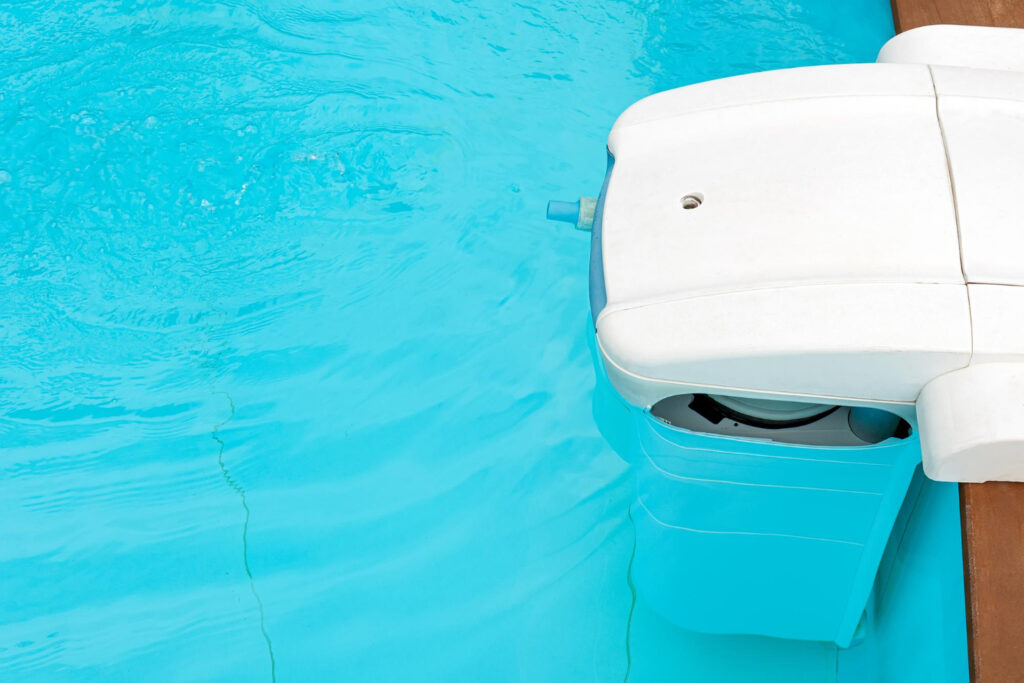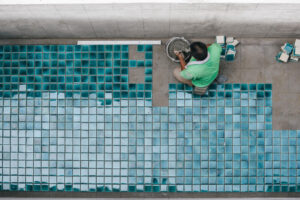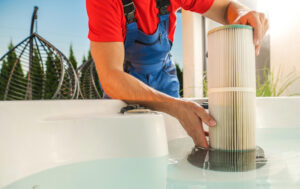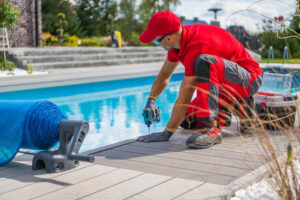Pool filters work hard to keep your water clean, but they don’t last forever. A pool filter replacement is needed when you notice cloudy water that won’t clear up, increased pressure readings, or visible damage to the filter material. These signs mean your filter can no longer do its job properly, no matter how much you clean it.
Many pool owners think cleaning their filter is enough to keep it working well. While regular cleaning helps, filters wear out over time and lose their ability to trap dirt and debris. Understanding when to replace versus when to clean can save you money and keep your pool water crystal clear.
In this article, we’ll walk you through the key warning signs that indicate it’s time for a new filter, help you choose the right replacement, and explain whether you can tackle this job yourself. You’ll also learn about costs and timing so you can plan ahead and avoid swimming in dirty water.
Below, we’ll walk through each important aspect of keeping your filter system effective and your water crystal clear:
- Why pool filters need replacement, not just cleaning
- Signs your pool filter may be going bad
- Choosing the right filter replacement for your pool
- How pool filter replacement works (and if you can DIY)
- Pool filter replacement cost and timing
Keep reading to know how to spot the warning signs that your pool filter needs replacement and what to expect in cost and timing.
Why pool filters need replacement, not just cleaning
Pool filters naturally wear down with use, making them less effective even after thorough cleaning. Eventually, cleaning can’t restore a filter’s original performance, and continued delays in replacement lead to cloudy water and equipment damage.
How filters wear down over time
Pool filters face constant stress from debris, chemicals, and water pressure. This daily wear changes their structure permanently.
Cartridge filters develop microscopic tears in their pleated material. These tiny holes let particles pass through that should be trapped. The fabric also becomes compressed over time, reducing its surface area.
Filter sand becomes rounded and smooth after months of use. Sharp edges that once caught debris wear away. The sand particles also get smaller, creating larger gaps between them.
DE filters lose their coating ability as the diatomaceous earth breaks down. The filter grids underneath can crack or tear from pressure changes during backwashing.
Chemical damage happens slowly but surely. Chlorine and other pool chemicals weaken filter materials. This makes them brittle and less effective at catching particles.
When pool filter repair is no longer enough
We can spot several signs that cleaning won’t fix our filter problems anymore.
Water stays cloudy even after thorough cleaning and balancing chemicals. This means the filter can’t trap particles like it used to.
Pressure readings stay high despite backwashing or cleaning. When a sand filter won’t drop pressure after backwashing, the sand needs replacement.
Cartridge filters show visible damage like tears, bent pleats, or fabric that won’t come clean. These problems can’t be fixed with cleaning alone.
EPA reports that cartridge filters, which don’t require backwashing, are the most water-efficient option—requiring significantly less annual water use compared to sand or DE systems.
The filter needs cleaning much more often than before. If we’re cleaning every few days instead of weekly, the filter is losing its capacity.
Pool equipment works harder to maintain water flow. Higher energy bills often signal that pumps are struggling against clogged or damaged filters.
What happens when you delay replacement
Putting off filter replacement creates bigger problems that cost more money later.
Water quality drops quickly without proper filtration. Bacteria and algae grow faster in poorly filtered water. This creates health risks for swimmers.
Our pool equipment suffers when filters don’t work properly. Pumps must work harder to push water through clogged filters. This extra strain shortens pump life and increases repair costs.
Chemical usage increases dramatically with poor filtration. We need more chlorine and other chemicals to keep water clean. This ongoing expense often costs more than a new filter.
Pool filter repair becomes impossible when damage spreads to other system parts. Delayed replacement can damage pump motors, heaters, and plumbing lines.
The pool becomes unusable during busy swimming season. Emergency repairs and water treatments take time when problems could have been prevented with timely filter replacement.
Signs your pool filter may be going bad
A failing pool filter shows clear warning signs that we can spot early. Poor water pressure, cloudy water, and unusual sounds from the filter unit are the main indicators that replacement time is approaching.
Low water pressure and poor circulation
When our pool filter starts failing, we notice reduced water flow from the return jets first. The pump works harder but moves less water through the system.
Common pressure problems include:
- Pressure gauge readings 8-10 psi above normal operating levels
- Weak water flow from pool returns
- Longer filtration cycles needed to clear the water
We should check our pressure gauge regularly. Most filters work best between 10-15 psi when clean. Once pressure stays above 25 psi even after cleaning, the filter media is likely worn out.
Poor circulation means chemicals don’t mix properly. Dead spots form in corners where debris collects. The water feels stagnant instead of moving smoothly.
Filter sand in pool or cloudy water
Filter sand appearing in our pool is a clear sign the filter needs replacement. We’ll see small grains of sand on the pool floor or floating in the water.
Water quality issues we notice:
- Persistent cloudy or hazy water
- Sand particles in skimmer baskets
- Algae growth despite proper chemical levels
When filter sand breaks down, it can’t trap small particles anymore. The sand becomes smooth and loses its sharp edges that catch dirt and debris.
Cloudy pool water that won’t clear after backwashing means the filter media is exhausted. We might also see a powdery substance in the water from worn filter sand.
Strange noises or leaks around the filter unit
Unusual sounds from our pool filter system signal internal problems. We hear grinding, rattling, or high-pitched whining when the pump runs.
Warning signs to watch for:
- Water leaking from tank seams or connections
- Loud grinding noises during operation
- Gurgling sounds in the filter tank
Leaks around the filter housing show worn seals or cracked components. Small drips can become major problems quickly. We should inspect all connections monthly.
Grinding noises often mean internal parts are damaged. The filter may have loose laterals or broken standpipe components that need professional attention.
Choosing the right filter replacement for your pool
When replacing your pool filter, you need to understand the three main types available and how each works with your specific pool setup. The key factors we’ll cover include comparing cartridge, sand, and DE systems, selecting quality filter sand, and ensuring your new filter matches your pool’s volume and pump capacity.
Cartridge, sand, and DE filter differences
Cartridge filters use pleated fabric elements that trap debris as water flows through. They’re easy to clean and replace but need more frequent maintenance than other types.
Sand filters push water through a bed of special filter sand that catches particles. The sand typically lasts 3-5 years before needing replacement.
DE filters use diatomaceous earth powder coated on grids inside the filter tank. They provide the finest filtration but require more complex maintenance.
Here’s how they compare:
| Filter Type | Filtration Level | Maintenance | Lifespan |
| Cartridge | Good (10-15 microns) | Easy, frequent | 1-2 years |
| Sand | Fair (20-40 microns) | Moderate | 3-5 years |
| DE | Best (2-5 microns) | Complex | 1-2 years |
Cartridge filters work best for smaller pools with light to moderate use. Sand filters handle heavy bather loads well. DE filters excel when you need crystal-clear water quality.
Finding quality filter sand for swimming pool systems
Pool filter sand must meet specific standards to work properly in your swimming pool system. Look for #20 silica sand with uniform grain size between 0.45-0.55mm.
Avoid construction sand or play sand. These contain impurities and inconsistent particle sizes that reduce filtration effectiveness.
Quality filter sand should be:
- Angular shaped for better debris trapping
- Chemically inert to prevent pH changes
- Properly sized to prevent sand loss through laterals
- Washed and screened to remove dust and debris
Replace filter sand every 3-5 years or when it becomes rounded and smooth from constant water flow. Worn sand loses its filtering ability and allows particles to pass through.
Purchase sand from pool supply stores rather than hardware stores. Pool-specific sand costs more but ensures proper filtration performance.
Matching filter size to pool volume and pump output
Your replacement filter must handle your pool’s total volume and work with your existing pump output. An undersized filter reduces water quality and strains your equipment.
Calculate your pool volume in gallons first. Then determine your pump’s flow rate in gallons per minute (GPM).
Filter sizing guidelines:
- Cartridge filter: 1 square foot of filter area per 10 GPM of pump output
- Sand filter: Tank diameter should handle your pump’s full flow rate
- DE filter: 1 square foot of filter area per 10 GPM of pump output
Check your pump nameplate for actual GPM output. Don’t use the maximum rated capacity since pumps rarely operate at peak performance.
Your filter should turn over the entire pool volume at least twice per day. Divide your pool volume by your pump’s GPM to find turnover time in minutes.
For example, a 20,000-gallon pool with a 50 GPM pump takes 400 minutes (6.7 hours) for one complete turnover.
ENERGY STAR certified pool pumps can prolong the lifespan of your filter system, reduce strain on plumbing, and deliver up to $290 in lifetime energy savings compared to standard pumps.
How pool filter replacement works (and if you can DIY)
Pool filter replacement involves removing your old filter and installing a new one in its place. While many homeowners can handle basic cartridge changes, more complex installations may require professional help to ensure proper function and safety.
Can I replace my own pool filter safely?
Yes, you can safely replace most pool filters yourself if you follow proper procedures and have basic tools. Cartridge filters are the easiest to replace since they simply slide in and out of their housing.
Sand and DE filters require more steps. You’ll need to turn off the pump, release pressure from the system, and disconnect plumbing connections. These filters are heavier and need careful handling.
Safety is key during any pool filter replacement. Always turn off power to your pool pump before starting. Never work on pressurized systems – release all pressure first.
Most filter housings have clear markings that show which direction parts should face. Take photos before removing the old filter to remember proper placement.
Basic mechanical skills help but aren’t required. If you can use a wrench and follow instructions, you can likely handle the job. The process typically takes 30-60 minutes for most filter types.
Tools and steps for a secure installation
Essential tools for pool filter replacement include:
- Adjustable wrench
- Screwdriver set
- Teflon tape
- Silicone lubricant
- Garden hose for cleaning
The replacement process follows these basic steps:
- Turn off the pump and switch off power at the breaker
- Release system pressure by opening the air relief valve
- Disconnect plumbing from the old filter housing
- Remove the old filter and clean the housing thoroughly
- Install the new filter following manufacturer directions
- Reconnect plumbing and check all connections for leaks
- Prime the system and restart the pump
Proper sealing prevents leaks. Use new O-rings with silicone lubricant. Wrap threaded connections with Teflon tape. Hand-tighten first, then use tools to snug connections without over-tightening.
Test your installation by running the system for several minutes. Check for leaks around all connections and ensure proper water flow.
Why pro installation ensures long-term performance
Professional installation guarantees proper sizing and compatibility. Pool technicians know which filters work best with your specific pump and plumbing setup. They can spot potential issues before they become problems.
Professionals have specialized tools that most homeowners don’t own. They can handle complex plumbing modifications if your new filter requires different connections than your old one.
Warranty protection often requires professional installation. Many filter manufacturers void warranties if you install the unit yourself. Professional installation typically includes a service guarantee.
Complex systems need expert knowledge. Multi-port valves, variable speed pumps, and integrated automation systems require understanding of how all components work together.
Time and stress savings matter too. Professionals complete installations quickly without multiple trips to hardware stores. They handle disposal of old equipment and clean up afterward.
Pool filter replacement cost and timing
Pool filter replacement costs typically range from $250 to $1,700, while timing depends on your filter type and pool usage patterns. Understanding these factors helps you budget effectively and maintain clean water year-round.
What is the average cost for a pool filter replacement?
Pool filter replacement costs vary significantly based on the type of system and installation requirements. The total cost ranges from $250 to $1,700 for both the unit and professional installation.
Here’s what we can expect for different components:
| Cost Component | Price Range |
| Filter unit only | $200 – $1,500 |
| Labor costs | $50 – $200 |
| Total replacement | $250 – $1,700 |
Cartridge filters are typically the most affordable option. Sand filters fall in the middle price range. DE (diatomaceous earth) filters represent the highest investment.
Several factors affect the final price. Pool size directly impacts filter requirements. More complex installations require additional labor costs.
We should also consider ongoing maintenance expenses. Some filter types need more frequent cleaning or media replacement. These recurring costs add up over time.
How often should a pool filter be replaced?
Filter replacement timing depends on the specific type of filtration system we’re using. Most manufacturers recommend replacing cartridge filters every 1-2 years.
Sand filters require media replacement every 3-5 years when properly maintained. The sand gradually loses its filtering ability as particles become rounded.
DE filters need new diatomaceous earth powder regularly. The grids themselves last 1-2 years with proper care.
Several factors influence replacement frequency:
- Pool usage levels – Heavy use shortens filter life
- Environmental conditions – Debris, pollen, and weather impact performance
- Water chemistry balance – Poor chemical maintenance damages filters faster
- Maintenance practices – Regular cleaning extends filter lifespan
Year-round pools need more frequent replacements than seasonal pools. We should watch for reduced water flow or cloudy water as warning signs.
Saving on repairs with timely upgrades
Timely filter replacement prevents costly pool repairs and equipment damage. When filters fail, debris circulates through the entire system.
This contamination can damage pumps, heaters, and other expensive equipment. Pump repairs alone can cost $200-800. Heater replacements often exceed $1,000.
Regular filter replacement protects our investment in pool equipment. Clean filters reduce strain on circulation pumps. This extends pump life significantly.
We can save money by replacing filters before they completely fail. Emergency repairs during peak season cost more than planned maintenance.
Proper timing also reduces chemical costs. Dirty filters require more chlorine and other chemicals to maintain water quality. Clean filters work more efficiently with standard chemical levels.
Seasonal replacement scheduling helps us budget effectively. We can purchase filters during off-season sales for additional savings.
Conclusion
We know that keeping track of your pool filter’s condition is key to clean water. The signs we covered make it easy to spot when replacement time arrives.
Regular checks help us catch problems early. This saves money and keeps our pool water safe for swimming.
Different filter types last different amounts of time. Sand filters work for years, while cartridge filters need changing more often.
We can prevent most pool problems by staying on top of filter maintenance. A working filter means clear water and fewer chemical issues.
The cost of a new filter is small compared to fixing water problems later. When we see the warning signs, it’s time to act.
Good filter care keeps our pool ready for use all season long. Clear water starts with a filter that works properly.
Schedule your pool filter replacement with Little Dipper to restore proper circulation, protect your equipment, and maintain safe swimming water.






